优化算法汇总
深度学习中的优化算法了解常用的优化算法
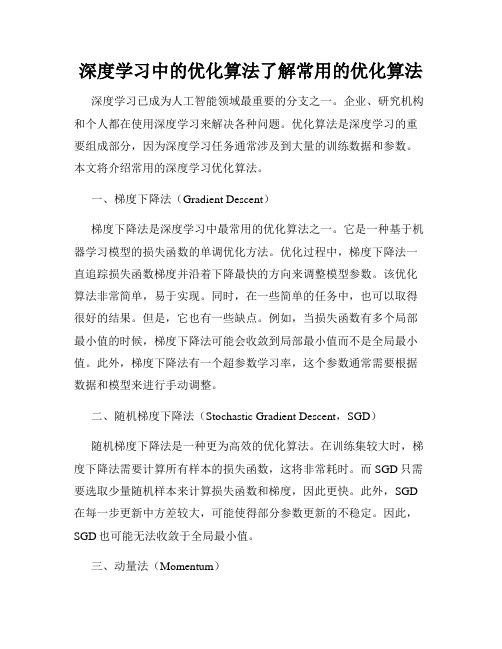
深度学习中的优化算法了解常用的优化算法深度学习已成为人工智能领域最重要的分支之一。
企业、研究机构和个人都在使用深度学习来解决各种问题。
优化算法是深度学习的重要组成部分,因为深度学习任务通常涉及到大量的训练数据和参数。
本文将介绍常用的深度学习优化算法。
一、梯度下降法(Gradient Descent)梯度下降法是深度学习中最常用的优化算法之一。
它是一种基于机器学习模型的损失函数的单调优化方法。
优化过程中,梯度下降法一直追踪损失函数梯度并沿着下降最快的方向来调整模型参数。
该优化算法非常简单,易于实现。
同时,在一些简单的任务中,也可以取得很好的结果。
但是,它也有一些缺点。
例如,当损失函数有多个局部最小值的时候,梯度下降法可能会收敛到局部最小值而不是全局最小值。
此外,梯度下降法有一个超参数学习率,这个参数通常需要根据数据和模型来进行手动调整。
二、随机梯度下降法(Stochastic Gradient Descent,SGD)随机梯度下降法是一种更为高效的优化算法。
在训练集较大时,梯度下降法需要计算所有样本的损失函数,这将非常耗时。
而SGD只需要选取少量随机样本来计算损失函数和梯度,因此更快。
此外,SGD 在每一步更新中方差较大,可能使得部分参数更新的不稳定。
因此,SGD也可能无法收敛于全局最小值。
三、动量法(Momentum)动量法是对梯度下降法进行的改进。
梯度下降法在更新参数时只考虑当前梯度值,这可能导致优化算法无法充分利用之前的梯度信息。
动量法引入了一个动量项,通过累积之前的参数更新方向,加速损失函数收敛。
因此,动量法可以在参数空间的多个方向上进行快速移动。
四、自适应梯度算法(AdaGrad、RMSProp和Adam)AdaGrad是一种适应性学习速率算法。
每个参数都拥有自己的学习率,根据其在之前迭代中的梯度大小进行调整。
每个参数的学习率都减小了它之前的梯度大小,从而使得训练后期的学习率变小。
RMSProp是AdaGrad的一种改进算法,他对学习率的衰减方式进行了优化,这使得它可以更好地应对非平稳目标函数。
matlab优化算法100例
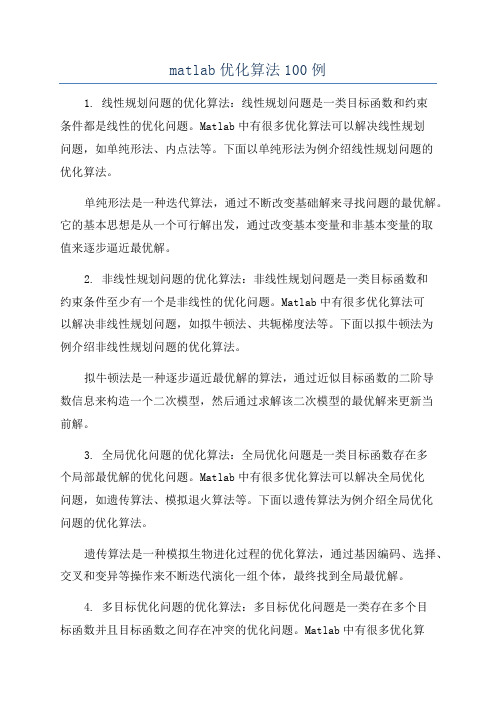
matlab优化算法100例1. 线性规划问题的优化算法:线性规划问题是一类目标函数和约束条件都是线性的优化问题。
Matlab中有很多优化算法可以解决线性规划问题,如单纯形法、内点法等。
下面以单纯形法为例介绍线性规划问题的优化算法。
单纯形法是一种迭代算法,通过不断改变基础解来寻找问题的最优解。
它的基本思想是从一个可行解出发,通过改变基本变量和非基本变量的取值来逐步逼近最优解。
2. 非线性规划问题的优化算法:非线性规划问题是一类目标函数和约束条件至少有一个是非线性的优化问题。
Matlab中有很多优化算法可以解决非线性规划问题,如拟牛顿法、共轭梯度法等。
下面以拟牛顿法为例介绍非线性规划问题的优化算法。
拟牛顿法是一种逐步逼近最优解的算法,通过近似目标函数的二阶导数信息来构造一个二次模型,然后通过求解该二次模型的最优解来更新当前解。
3. 全局优化问题的优化算法:全局优化问题是一类目标函数存在多个局部最优解的优化问题。
Matlab中有很多优化算法可以解决全局优化问题,如遗传算法、模拟退火算法等。
下面以遗传算法为例介绍全局优化问题的优化算法。
遗传算法是一种模拟生物进化过程的优化算法,通过基因编码、选择、交叉和变异等操作来不断迭代演化一组个体,最终找到全局最优解。
4. 多目标优化问题的优化算法:多目标优化问题是一类存在多个目标函数并且目标函数之间存在冲突的优化问题。
Matlab中有很多优化算法可以解决多目标优化问题,如多目标粒子群优化算法、多目标遗传算法等。
下面以多目标粒子群优化算法为例介绍多目标优化问题的优化算法。
多目标粒子群优化算法是一种基于粒子群优化算法的多目标优化算法,通过在粒子的速度更新过程中考虑多个目标函数来实现多目标优化。
5. 其他优化算法:除了上述提到的优化算法,Matlab还提供了很多其他的优化算法,如模拟退火算法、蚁群算法等。
这些算法可以根据具体的问题选择合适的算法进行求解。
综上所述,Matlab提供了丰富的优化算法,可以解决不同类型的优化问题。
智能优化算法总结

智能优化算法总结优化算法有很多,经典算法包括:有线性规划,动态规划等;改进型局部搜索算法包括爬山法,最速下降法等,模拟退火、遗传算法以及禁忌搜索称作指导性搜索法。
而神经网络,混沌搜索则属于系统动态演化方法。
梯度为基础的传统优化算法具有较高的计算效率、较强的可靠性、比较成熟等优点,是一类最重要的、应用最广泛的优化算法。
但是,传统的最优化方法在应用于复杂、困难的优化问题时有较大的局限性。
一个优化问题称为是复杂的,通常是指具有下列特征之一:(1)目标函数没有明确解析表达;(2)目标函数虽有明确表达,但不可能恰好估值;(3)目标函数为多峰函数;(4)目标函数有多个,即多目标优化。
一个优化问题称为是困难的,通常是指:目标函数或约束条件不连续、不可微、高度非线性,或者问题本身是困难的组合问题。
传统优化方法往往要求目标函数是凸的、连续可微的,可行域是凸集等条件,而且处理非确定性信息的能力较差。
这些弱点使传统优化方法在解决许多实际问题时受到了限制。
智能优化算法一般都是建立在生物智能或物理现象基础上的随机搜索算法,目前在理论上还远不如传统优化算法完善,往往也不能确保解的最优性,因而常常被视为只是一些“元启发式方法”(meta-heuristic)。
但从实际应用的观点看,这类新算法一般不要求目标函数和约束的连续性与凸性,甚至有时连有没有解析表达式都不要求,对计算中数据的不确定性也有很强的适应能力。
下面给出一个局部搜索,模拟退火,遗传算法,禁忌搜索的形象比喻:为了找出地球上最高的山,一群有志气的兔子们开始想办法。
1.兔子朝着比现在高的地方跳去。
他们找到了不远处的最高山峰。
但是这座山不一定是珠穆朗玛峰。
这就是局部搜索,它不能保证局部最优值就是全局最优值。
2.兔子喝醉了。
他随机地跳了很长时间。
这期间,它可能走向高处,也可能踏入平地。
但是,他渐渐清醒了并朝最高方向跳去。
这就是模拟退火。
3.兔子们吃了失忆药片,并被发射到太空,然后随机落到了地球上的某些地方。
数值优化算法
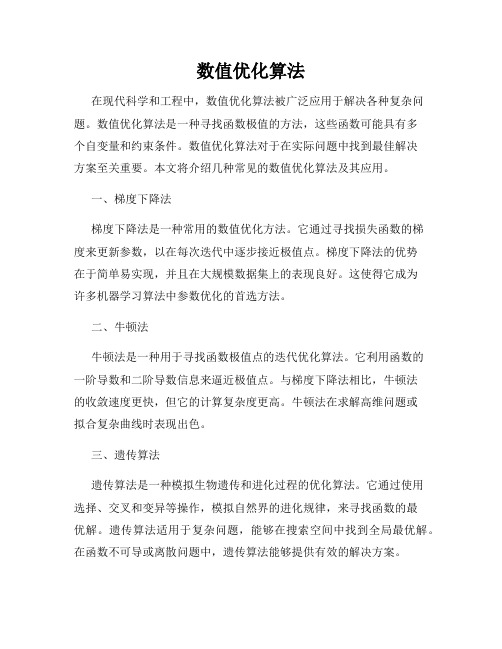
数值优化算法在现代科学和工程中,数值优化算法被广泛应用于解决各种复杂问题。
数值优化算法是一种寻找函数极值的方法,这些函数可能具有多个自变量和约束条件。
数值优化算法对于在实际问题中找到最佳解决方案至关重要。
本文将介绍几种常见的数值优化算法及其应用。
一、梯度下降法梯度下降法是一种常用的数值优化方法。
它通过寻找损失函数的梯度来更新参数,以在每次迭代中逐步接近极值点。
梯度下降法的优势在于简单易实现,并且在大规模数据集上的表现良好。
这使得它成为许多机器学习算法中参数优化的首选方法。
二、牛顿法牛顿法是一种用于寻找函数极值点的迭代优化算法。
它利用函数的一阶导数和二阶导数信息来逼近极值点。
与梯度下降法相比,牛顿法的收敛速度更快,但它的计算复杂度更高。
牛顿法在求解高维问题或拟合复杂曲线时表现出色。
三、遗传算法遗传算法是一种模拟生物遗传和进化过程的优化算法。
它通过使用选择、交叉和变异等操作,模拟自然界的进化规律,来寻找函数的最优解。
遗传算法适用于复杂问题,能够在搜索空间中找到全局最优解。
在函数不可导或离散问题中,遗传算法能够提供有效的解决方案。
四、模拟退火算法模拟退火算法是一种启发式搜索算法,模拟了金属退火过程中原子随温度变化的行为。
模拟退火算法以一定的概率接受更差的解,并以较低的概率逐渐收敛到全局最优解。
模拟退火算法对局部极小点有一定的免疫能力,并且在大规模离散优化问题中表现出优越性。
五、粒子群算法粒子群算法是一种基于群体行为的优化算法。
它模拟了鸟群觅食的行为,通过迭代寻找问题的最优解。
粒子群算法通过评估适应度函数来引导粒子的移动,从而逐渐靠近最优解。
这种算法适用于多目标优化问题和高维函数优化。
结论数值优化算法在科学和工程领域扮演着至关重要的角色。
梯度下降法、牛顿法、遗传算法、模拟退火算法和粒子群算法是几种常见的数值优化方法。
它们各自具有不同的优势和适用范围,可以根据问题的特点选择合适的优化算法。
通过应用这些优化算法,可以帮助科学家和工程师在实际问题中找到最佳解决方案,推动技术的进步和创新。
常见的优化算法

常见的优化算法
摘要:
1.优化算法的定义和分类
2.最大化和最小化问题
3.梯度下降法
4.牛顿法
5.拟牛顿法
6.共轭梯度法
7.遗传算法
8.模拟退火算法
9.人工神经网络
正文:
优化算法是数学和计算机科学的一个分支,主要研究如何找到一个函数的最小值或最大值。
在实际应用中,优化问题可以分为最大化和最小化两种类型。
为了求解这类问题,人们研究了许多优化算法,下面我们来介绍一些常见的优化算法。
首先,我们来了解一些基本的优化算法。
梯度下降法是一种非常常见的优化算法,它通过计算目标函数的梯度来不断更新参数,从而使函数值逐渐下降。
牛顿法和拟牛顿法则是基于牛顿- 莱布尼茨公式来求解优化问题的方法,它们具有比梯度下降法更快的收敛速度。
共轭梯度法则是一种高效的线性规划算法,它可以在保证解全局收敛的同时,大幅提高求解速度。
除了这些传统的优化算法,还有一些新兴的优化算法。
遗传算法是一种模
拟自然界生物进化过程的优化方法,它通过基因的遗传、变异和选择来逐步改进解的质量。
模拟退火算法则是一种模拟金属冶炼过程的优化算法,它通过模拟金属冶炼过程中的退火过程来寻找全局最优解。
人工神经网络是一种模拟人脑神经网络进行信息处理的优化算法,它通过调整神经网络中的权重和阈值来逼近目标函数。
总之,优化算法是解决实际问题的重要工具,不同的优化算法适用于不同的问题。
了解这些算法的原理和特点,可以帮助我们更好地选择合适的方法来求解实际问题。
常见的优化算法
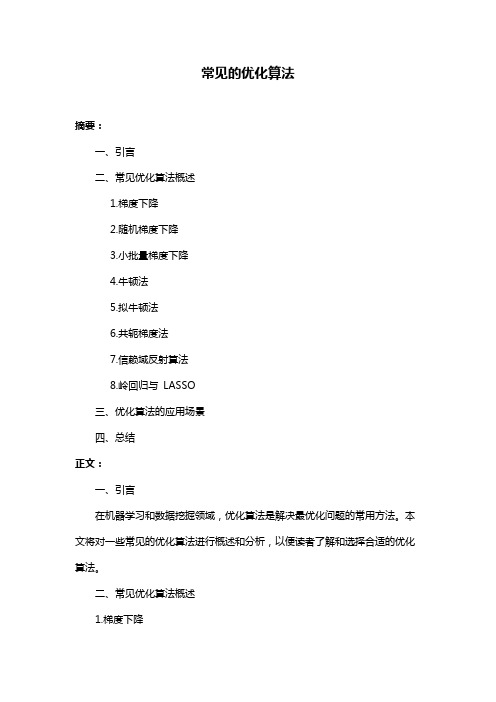
常见的优化算法摘要:一、引言二、常见优化算法概述1.梯度下降2.随机梯度下降3.小批量梯度下降4.牛顿法5.拟牛顿法6.共轭梯度法7.信赖域反射算法8.岭回归与LASSO三、优化算法的应用场景四、总结正文:一、引言在机器学习和数据挖掘领域,优化算法是解决最优化问题的常用方法。
本文将对一些常见的优化算法进行概述和分析,以便读者了解和选择合适的优化算法。
二、常见优化算法概述1.梯度下降梯度下降是最基本的优化算法,通过计算目标函数的梯度,并乘以一个正数加到梯度相反号上,不断更新参数。
2.随机梯度下降随机梯度下降是梯度下降的一个变种,每次更新时随机选择一部分样本计算梯度,减少了计算复杂度。
3.小批量梯度下降小批量梯度下降是随机梯度下降的改进,每次更新时选择一小部分样本计算梯度,平衡了计算复杂度和收敛速度。
4.牛顿法牛顿法是一种二阶优化算法,通过计算目标函数的二阶导数(Hessian 矩阵)来更新参数,具有更快的收敛速度。
5.拟牛顿法拟牛顿法是牛顿法的近似方法,通过正则化Hessian 矩阵来避免牛顿法的计算复杂度问题。
6.共轭梯度法共轭梯度法是一种高效的优化算法,通过计算目标函数在参数空间中的共轭梯度来更新参数,具有较好的数值稳定性和收敛速度。
7.信赖域反射算法信赖域反射算法是一种基于信赖域的优化算法,通过不断缩小区间来更新参数,具有较好的收敛速度和鲁棒性。
8.岭回归与LASSO岭回归和LASSO 是一种正则化方法,通过加入正则项来优化目标函数,具有较好的过拟合抑制效果。
三、优化算法的应用场景不同的优化算法具有不同的特点和适用场景,如梯度下降适用于简单的问题,牛顿法和拟牛顿法适用于非凸问题,共轭梯度法适用于高维问题等。
在实际应用中,需要根据问题的特点选择合适的优化算法。
四、总结本文对常见的优化算法进行了概述和分析,包括梯度下降、随机梯度下降、小批量梯度下降、牛顿法、拟牛顿法、共轭梯度法、信赖域反射算法、岭回归和LASSO 等。
人工智能中的优化算法比较

人工智能中的优化算法主要用于寻找最优解或最优参数,可以应用于各种问题,如机器学习模型训练、路径规划、资源分配等。
以下是一些常见的优化算法的比较:
1. 梯度下降法:是最基础的优化算法之一,用于找到函数的最小值。
其中的随机梯度下降法(SGD)在处理大规模数据和模型时尤其有效。
2. 牛顿法:是一种寻找函数的零点的优化算法,优点是能快速找到函数的局部最小值,缺点是可能陷入局部最优。
3. 共轭梯度法:是一种在梯度下降法的基础上改进的算法,可以处理具有非凸函数和多个极小值的优化问题,但计算复杂度较高。
4. 遗传算法:是一种模拟自然选择和遗传学机制的优化算法,适用于大规模搜索和多峰概率问题,但可能找不到全局最优解。
5. 模拟退火算法:是一种寻找全局最优的优化算法,通过引入温度参数和退火机制,能够处理具有约束条件的优化问题,但温度参数的选择会影响算法的性能。
6. 蚁群优化算法:是一种受自然界中蚂蚁寻径行为启发的优化算法,适用于大规模搜索问题,但易陷入局部最优解。
这些算法各有优缺点,适用于不同的问题和场景。
在实际应用中,需要根据具体问题选择合适的算法,并进行相应的调整和优化。
同时,也可以将多种算法结合起来使用,以提高搜索效率和精度。
数学技术中常用的优化算法及使用技巧
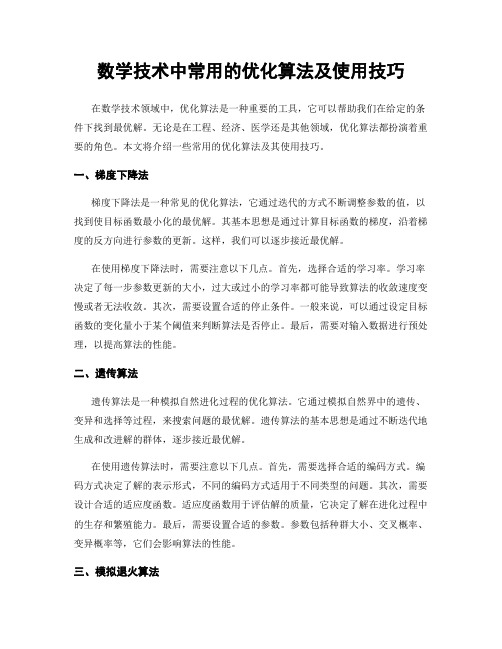
数学技术中常用的优化算法及使用技巧在数学技术领域中,优化算法是一种重要的工具,它可以帮助我们在给定的条件下找到最优解。
无论是在工程、经济、医学还是其他领域,优化算法都扮演着重要的角色。
本文将介绍一些常用的优化算法及其使用技巧。
一、梯度下降法梯度下降法是一种常见的优化算法,它通过迭代的方式不断调整参数的值,以找到使目标函数最小化的最优解。
其基本思想是通过计算目标函数的梯度,沿着梯度的反方向进行参数的更新。
这样,我们可以逐步接近最优解。
在使用梯度下降法时,需要注意以下几点。
首先,选择合适的学习率。
学习率决定了每一步参数更新的大小,过大或过小的学习率都可能导致算法的收敛速度变慢或者无法收敛。
其次,需要设置合适的停止条件。
一般来说,可以通过设定目标函数的变化量小于某个阈值来判断算法是否停止。
最后,需要对输入数据进行预处理,以提高算法的性能。
二、遗传算法遗传算法是一种模拟自然进化过程的优化算法。
它通过模拟自然界中的遗传、变异和选择等过程,来搜索问题的最优解。
遗传算法的基本思想是通过不断迭代地生成和改进解的群体,逐步接近最优解。
在使用遗传算法时,需要注意以下几点。
首先,需要选择合适的编码方式。
编码方式决定了解的表示形式,不同的编码方式适用于不同类型的问题。
其次,需要设计合适的适应度函数。
适应度函数用于评估解的质量,它决定了解在进化过程中的生存和繁殖能力。
最后,需要设置合适的参数。
参数包括种群大小、交叉概率、变异概率等,它们会影响算法的性能。
三、模拟退火算法模拟退火算法是一种基于物理退火过程的优化算法。
它通过模拟固体物体在高温下冷却的过程,来搜索问题的最优解。
模拟退火算法的基本思想是通过接受一定概率的劣解,以避免陷入局部最优解。
在使用模拟退火算法时,需要注意以下几点。
首先,需要选择合适的初始温度和退火率。
初始温度决定了算法开始时接受劣解的概率,退火率决定了温度的下降速度。
其次,需要设计合适的能量函数。
能量函数用于评估解的质量,它决定了解在退火过程中的接受概率。
电力系统优化规划算法总结

1.期望值算法
期望值算法通常是用期望值代替随机因素,将问题转化为确定性问题考虑。
2.机会约束算法
主要是考虑概率问题,如在置信区间范围内考虑优化问题,就转化为概率约束的问题。
3.相关机会规划算法
是在随机环境下使得事件的机会达到最优。
4.智能优化
目前随机问题多用智能优化法。
智能优化主要借鉴仿生学和拟物的思想,包括:遗传算法、粒子群算法、蚁群算法等。
(1)遗传算法属于进化算法的一种,它通过模仿自然界的选择与遗传的机理来寻找最优解. 遗传算法有三个基本算子:选择、交叉和变异. 但是遗传算法的编程实现比较复杂,首先需要对问题进行编码,找到最优解之后还需要对问题进行解码,另外三个算子的实现也有许多参数,如交叉率和变异率,并且这些参数的选择严重影响解的品质,而目前这些参数的选
择大部分是依靠经验。
(2)粒子群算法
粒子群算法,是一种基于迭代的优化进化并行算法,和模拟退火算法相似,系统从随机解出发,通过迭代寻找最优解,但它比遗传算法规则更为简单,它没有遗传算法的“交叉”和“变异”操作,它通过粒子在解空间追随当前搜索到的最优值来寻找全局最优。
(3)蚁群算法
蚁群算法是一种用来在图中寻找优化路径的机率型算法,是一种模拟进化算法,来源于蚂蚁在寻找食物过程中发现路径的行为。
常用的优化方法和优化函数
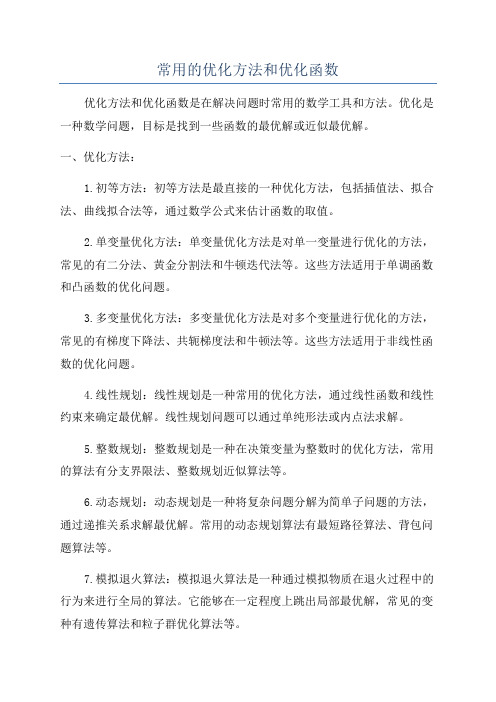
常用的优化方法和优化函数优化方法和优化函数是在解决问题时常用的数学工具和方法。
优化是一种数学问题,目标是找到一些函数的最优解或近似最优解。
一、优化方法:1.初等方法:初等方法是最直接的一种优化方法,包括插值法、拟合法、曲线拟合法等,通过数学公式来估计函数的取值。
2.单变量优化方法:单变量优化方法是对单一变量进行优化的方法,常见的有二分法、黄金分割法和牛顿迭代法等。
这些方法适用于单调函数和凸函数的优化问题。
3.多变量优化方法:多变量优化方法是对多个变量进行优化的方法,常见的有梯度下降法、共轭梯度法和牛顿法等。
这些方法适用于非线性函数的优化问题。
4.线性规划:线性规划是一种常用的优化方法,通过线性函数和线性约束来确定最优解。
线性规划问题可以通过单纯形法或内点法求解。
5.整数规划:整数规划是一种在决策变量为整数时的优化方法,常用的算法有分支界限法、整数规划近似算法等。
6.动态规划:动态规划是一种将复杂问题分解为简单子问题的方法,通过递推关系求解最优解。
常用的动态规划算法有最短路径算法、背包问题算法等。
7.模拟退火算法:模拟退火算法是一种通过模拟物质在退火过程中的行为来进行全局的算法。
它能够在一定程度上跳出局部最优解,常见的变种有遗传算法和粒子群优化算法等。
8.遗传算法:遗传算法是一种基于自然选择和遗传机制的优化算法,通过模拟自然界的进化过程来优化问题。
它常用于求解复杂的问题,如函数逼近、组合优化等。
9.神经网络:神经网络是一种通过模拟神经元之间的连接和传输信息来建立模型的方法。
通过训练网络参数,可以实现优化目标函数。
二、常用的优化函数:1. Rosenbrock函数:Rosenbrock函数是一个经典优化函数,用于测试优化算法的性能。
其函数形式为 f(x,y) = (1-x)^2 + 100(y-x^2)^2,目标是找到函数的全局最小值。
2. Ackley函数:Ackley函数是另一个经典的优化函数,用于测试优化算法的鲁棒性。
优化算法改进策略总结

优化算法改进策略总结
优化算法改进策略总结的关键是根据具体问题的特点,选择合适的改进策略和技巧。
下面总结几种常见的优化算法改进策略:
1.贪心策略:贪心算法选择局部最优解,并希望通过不断选择
局部最优解来达到全局最优解。
贪心策略适用于那些具有贪心选择性质的问题。
2.动态规划:动态规划通过将原问题划分为多个子问题,并保
存子问题的解,通过递推求解子问题来得到原问题的解。
动态规划适用于具有重叠子问题和最优子结构的问题。
3.分支界定:分支界定通过建立一个解空间树,将搜索过程转
化为对解空间树的遍历,通过剪枝操作来减少搜索空间。
分支界定适用于具有可行解空间结构的问题。
4.回溯法:回溯法通过试探和回溯的方式来寻找问题的解,它
适用于具有多个可能解,并且每个可能解满足一定的约束条件的问题。
5.深度优先搜索:深度优先搜索通过不断地向前搜索到不能再
继续搜索为止,然后回退到上一个节点,再继续搜索。
深度优先搜索适用于解空间较大,但解的深度较小的问题。
6.广度优先搜索:广度优先搜索通过不断地将当前节点的所有
相邻节点入队,然后按照队列中的顺序进行遍历,直到找到目标节点或者遍历完所有节点。
广度优先搜索适用于解空间较小,
但解的广度较大的问题。
总的来说,对于优化算法的改进策略,需要根据具体问题的特点进行选择,针对问题的特点使用合适的算法和技巧,以提高算法的效率和准确性。
优化算法小结
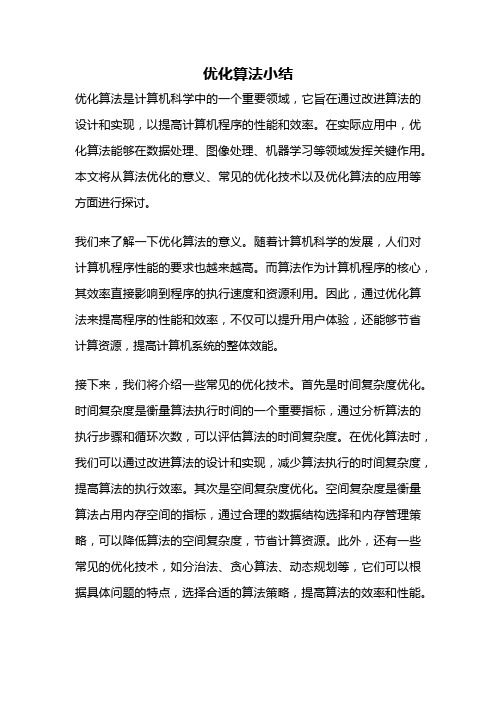
优化算法小结优化算法是计算机科学中的一个重要领域,它旨在通过改进算法的设计和实现,以提高计算机程序的性能和效率。
在实际应用中,优化算法能够在数据处理、图像处理、机器学习等领域发挥关键作用。
本文将从算法优化的意义、常见的优化技术以及优化算法的应用等方面进行探讨。
我们来了解一下优化算法的意义。
随着计算机科学的发展,人们对计算机程序性能的要求也越来越高。
而算法作为计算机程序的核心,其效率直接影响到程序的执行速度和资源利用。
因此,通过优化算法来提高程序的性能和效率,不仅可以提升用户体验,还能够节省计算资源,提高计算机系统的整体效能。
接下来,我们将介绍一些常见的优化技术。
首先是时间复杂度优化。
时间复杂度是衡量算法执行时间的一个重要指标,通过分析算法的执行步骤和循环次数,可以评估算法的时间复杂度。
在优化算法时,我们可以通过改进算法的设计和实现,减少算法执行的时间复杂度,提高算法的执行效率。
其次是空间复杂度优化。
空间复杂度是衡量算法占用内存空间的指标,通过合理的数据结构选择和内存管理策略,可以降低算法的空间复杂度,节省计算资源。
此外,还有一些常见的优化技术,如分治法、贪心算法、动态规划等,它们可以根据具体问题的特点,选择合适的算法策略,提高算法的效率和性能。
优化算法在实际应用中具有广泛的应用价值。
在数据处理方面,优化算法可以加速数据的存储和检索,提高数据处理的效率。
例如,在大规模数据集上进行快速搜索和排序,可以利用索引结构和排序算法进行优化,减少搜索和排序的时间复杂度。
在图像处理方面,优化算法可以提高图像处理的速度和质量。
例如,在图像压缩和图像识别中,可以通过优化算法来降低计算复杂度,提高图像处理的效果。
在机器学习方面,优化算法可以加速模型的训练和推理,提高机器学习的效率和准确性。
例如,在神经网络的训练过程中,可以利用优化算法来优化模型的参数,提高模型的性能。
总结起来,优化算法是提高计算机程序性能和效率的重要手段。
运筹学中的优化算法与算法设计
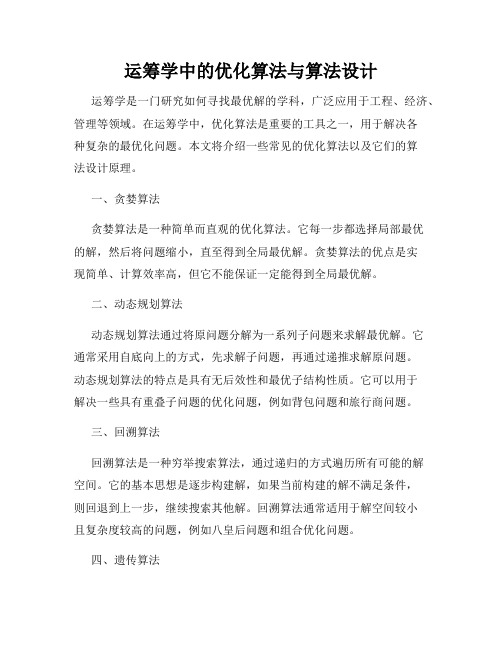
运筹学中的优化算法与算法设计运筹学是一门研究如何寻找最优解的学科,广泛应用于工程、经济、管理等领域。
在运筹学中,优化算法是重要的工具之一,用于解决各种复杂的最优化问题。
本文将介绍一些常见的优化算法以及它们的算法设计原理。
一、贪婪算法贪婪算法是一种简单而直观的优化算法。
它每一步都选择局部最优的解,然后将问题缩小,直至得到全局最优解。
贪婪算法的优点是实现简单、计算效率高,但它不能保证一定能得到全局最优解。
二、动态规划算法动态规划算法通过将原问题分解为一系列子问题来求解最优解。
它通常采用自底向上的方式,先求解子问题,再通过递推求解原问题。
动态规划算法的特点是具有无后效性和最优子结构性质。
它可以用于解决一些具有重叠子问题的优化问题,例如背包问题和旅行商问题。
三、回溯算法回溯算法是一种穷举搜索算法,通过递归的方式遍历所有可能的解空间。
它的基本思想是逐步构建解,如果当前构建的解不满足条件,则回退到上一步,继续搜索其他解。
回溯算法通常适用于解空间较小且复杂度较高的问题,例如八皇后问题和组合优化问题。
四、遗传算法遗传算法是一种借鉴生物进化过程中的遗传和适应度思想的优化算法。
它通过模拟自然选择、交叉和变异等过程,生成新的解,并通过适应度函数评估解的质量。
遗传算法具有全局搜索能力和并行搜索能力,适用于解决复杂的多参数优化问题。
五、模拟退火算法模拟退火算法是一种模拟金属退火过程的优化算法。
它通过接受劣解的概率来避免陷入局部最优解,从而有一定概率跳出局部最优解寻找全局最优解。
模拟退火算法的核心是温度控制策略,逐渐降低温度以减小接受劣解的概率。
它适用于求解连续变量的全局优化问题。
六、禁忌搜索算法禁忌搜索算法是一种基于局部搜索的优化算法。
它通过维护一个禁忌表来避免回到之前搜索过的解,以克服局部最优解的限制。
禁忌搜索算法引入了记忆机制,能够在搜索过程中有一定的随机性,避免陷入局部最优解。
它适用于求解离散变量的组合优化问题。
综上所述,运筹学中的优化算法涵盖了贪婪算法、动态规划算法、回溯算法、遗传算法、模拟退火算法和禁忌搜索算法等多种方法。
优化算法改进策略总结

优化算法改进策略总结以优化算法改进策略总结为标题的文章如下:在计算机科学中,算法优化是提高算法性能和效率的关键步骤。
通过对算法进行改进和优化,可以使计算机程序更快、更准确地执行任务。
本文将总结一些常用的优化算法改进策略,帮助读者更好地理解和应用这些策略。
一、分而治之思想分而治之思想是一种将复杂问题分解为更小、更简单的子问题,然后逐个解决的方法。
通过将问题分解为多个子问题,可以降低问题的复杂度,从而提高算法的效率。
在实践中,可以使用递归算法或迭代算法来实现分而治之思想。
二、动态规划动态规划是一种通过将问题分解为子问题的方式来解决复杂问题的方法。
通过使用一个表格来存储已计算的中间结果,可以避免重复计算,从而提高算法的效率。
动态规划常用于解决最优化问题,如最短路径、背包问题等。
三、贪婪算法贪婪算法是一种通过每一步选择当前最优解来逐步构建解决方案的方法。
贪婪算法通常简单且高效,但并不保证得到最优解。
因此,在使用贪婪算法时需要注意问题的特性和限制条件,以确保得到满意的解决方案。
四、回溯算法回溯算法是一种通过逐步尝试所有可能的解决方案来解决问题的方法。
回溯算法通常用于解决组合问题、排列问题等。
在实践中,可以通过剪枝操作来减少不必要的尝试,提高算法的效率。
五、启发式算法启发式算法是一种通过模拟自然界的演化过程来搜索问题空间的方法。
启发式算法通常使用某种评估函数来评估解决方案的质量,并根据评估结果进行搜索和优化。
常见的启发式算法包括遗传算法、模拟退火算法等,它们可以在大规模、复杂的问题中找到较好的解决方案。
六、并行计算并行计算是一种通过同时执行多个计算任务来提高算法效率的方法。
通过将问题分解为多个子问题,然后并行地解决这些子问题,可以加速算法的执行过程。
并行计算适用于多核处理器、分布式系统等环境,可以极大地提高算法的运行速度。
七、数据结构优化数据结构优化是一种通过选择合适的数据结构来提高算法效率的方法。
合适的数据结构可以使算法的执行过程更快、更简单。
运筹学的优化算法

运筹学的优化算法运筹学是一门研究如何对复杂问题进行优化的学科,通过利用数学、统计学和计算机科学等方法,运筹学可以帮助解决各种决策和优化问题。
在该领域中,存在着许多不同的优化算法,下面将介绍其中几种常见的算法。
1. 线性规划(Linear Programming,LP):线性规划是一种常见的数学规划方法。
它的目标是优化一个线性目标函数,同时满足一组线性约束条件。
通过将问题转化为标准形式(即将约束条件和目标函数都表示为线性等式或不等式),线性规划可以使用诸如单纯形法、内点法等算法进行求解。
2. 整数规划(Integer Programming,IP):整数规划是一种在线性规划的基础上,引入了变量为整数的约束条件。
这样的问题更具挑战性,因为整数约束使得问题成为NP困难问题。
针对整数规划问题,常用的方法包括分支定界法、回溯法、割平面法等。
3. 非线性规划(Nonlinear Programming,NLP):与线性规划不同,非线性规划的目标函数或约束条件至少有一个是非线性的。
非线性规划的求解需要使用迭代算法,例如牛顿法、拟牛顿法、遗传算法等。
这些算法通过逐步优化解来逼近最优解。
4. 动态规划(Dynamic Programming,DP):动态规划通过将问题分解为子问题,并使用递归方式求解子问题,最终建立起最优解的数学模型。
动态规划方法常用于具有重叠子问题和最优子结构性质的问题。
例如,背包问题、最短路径问题等。
5. 启发式算法(Heuristic Algorithm):启发式算法是一种近似求解优化问题的方法,它通过启发式策略和经验知识来指导过程,寻找高质量解而不必找到最优解。
常见的启发式算法包括模拟退火算法、遗传算法、粒子群算法等。
6. 蒙特卡洛模拟(Monte Carlo Simulation):蒙特卡洛模拟是一种基于概率的数值模拟方法,用于评估随机系统中的不确定性和风险。
它通过生成大量随机样本,并使用这些样本的统计特征来近似计算数学模型的输出结果。
优化算法的分类

优化算法的分类优化算法是一种用于找到问题的最优解或近似最优解的方法。
在计算机科学和运筹学领域,优化算法被广泛应用于解决各种实际问题,例如机器学习、图像处理、网络设计等。
优化算法的分类可以根据其基本原理或应用领域进行划分。
本文将介绍一些常见的优化算法分类。
1. 传统优化算法传统优化算法是指早期开发的基于数学原理的算法。
这些算法通常基于确定性模型和数学规则来解决问题。
以下是一些常见的传统优化算法:(1) 穷举法穷举法是一种朴素的优化算法,它通过遍历所有可能的解空间来寻找最优解。
穷举法的优点是能够找到全局最优解(如果存在),缺点是搜索空间过大时会非常耗时。
(2) 贪婪算法贪婪算法是一种启发式算法,它通过每一步选择当前状态下最优的决策,从而逐步构建最优解。
贪婪算法的优势是简单快速,但它可能无法找到全局最优解,因为它只考虑了当前最优的选择。
(3) 动态规划动态规划是一种基于最优子结构和重叠子问题性质的优化算法。
它将原问题拆分为一系列子问题,并通过保存子问题的解来避免重复计算。
动态规划的优点是可以高效地求解复杂问题,例如最短路径问题和背包问题。
(4) 分支界限法分支界限法是一种搜索算法,它通过不断分割搜索空间并限制搜索范围,以找到最优解。
分支界限法可以解决一些组合优化问题,如旅行商问题和图着色问题。
2. 随机优化算法随机优化算法是基于概率和随机性的算法,通过引入随机扰动来逐步寻找最优解。
以下是一些常见的随机优化算法:(1) 模拟退火算法模拟退火算法模拟了固体物体冷却过程中的原子运动,通过逐步减小随机扰动的概率来搜索最优解。
模拟退火算法可以通过接受劣解来避免陷入局部最优解。
(2) 遗传算法遗传算法模拟了生物进化过程,通过遗传操作(如交叉和变异)来搜索最优解。
遗传算法通常包括种群初始化、选择、交叉和变异等步骤,能够自适应地搜索解空间。
(3) 蚁群算法蚁群算法模拟了蚂蚁在寻找食物时的行为,通过蚂蚁之间的信息交流和挥发性信息素来搜索最优解。
计算机网络优化算法
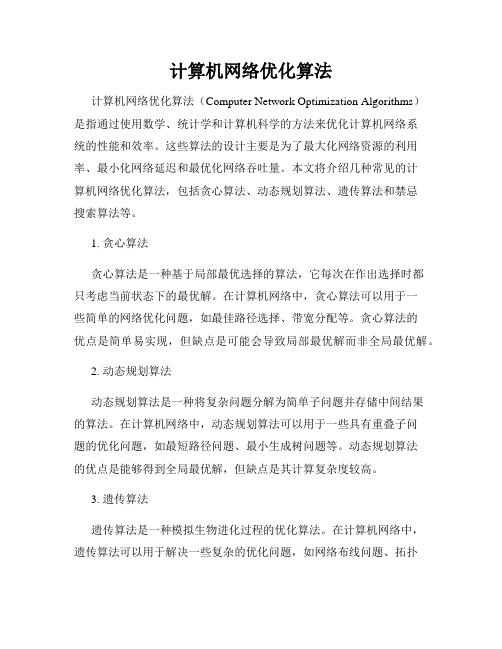
计算机网络优化算法计算机网络优化算法(Computer Network Optimization Algorithms)是指通过使用数学、统计学和计算机科学的方法来优化计算机网络系统的性能和效率。
这些算法的设计主要是为了最大化网络资源的利用率、最小化网络延迟和最优化网络吞吐量。
本文将介绍几种常见的计算机网络优化算法,包括贪心算法、动态规划算法、遗传算法和禁忌搜索算法等。
1. 贪心算法贪心算法是一种基于局部最优选择的算法,它每次在作出选择时都只考虑当前状态下的最优解。
在计算机网络中,贪心算法可以用于一些简单的网络优化问题,如最佳路径选择、带宽分配等。
贪心算法的优点是简单易实现,但缺点是可能会导致局部最优解而非全局最优解。
2. 动态规划算法动态规划算法是一种将复杂问题分解为简单子问题并存储中间结果的算法。
在计算机网络中,动态规划算法可以用于一些具有重叠子问题的优化问题,如最短路径问题、最小生成树问题等。
动态规划算法的优点是能够得到全局最优解,但缺点是其计算复杂度较高。
3. 遗传算法遗传算法是一种模拟生物进化过程的优化算法。
在计算机网络中,遗传算法可以用于解决一些复杂的优化问题,如网络布线问题、拓扑优化问题等。
遗传算法的优点是能够找到较好的全局最优解,但缺点是其计算复杂度高且需要大量的计算资源。
4. 禁忌搜索算法禁忌搜索算法是一种通过记录和管理搜索路径来避免陷入局部最优解的优化算法。
在计算机网络中,禁忌搜索算法可以用于解决一些带有约束条件的优化问题,如链路带宽分配问题、网络拓扑优化问题等。
禁忌搜索算法的优点是能够在可行解空间中进行有效搜索,但缺点是其计算复杂度较高且需要适当的启发式规则。
综上所述,计算机网络优化算法是一类用于改善计算机网络系统性能的关键算法。
选择合适的网络优化算法取决于具体的问题和限制条件。
贪心算法适用于简单的问题,动态规划算法适用于具有重叠子问题的问题,遗传算法适用于复杂的问题,禁忌搜索算法适用于带有约束条件的问题。
优化算法分类范文
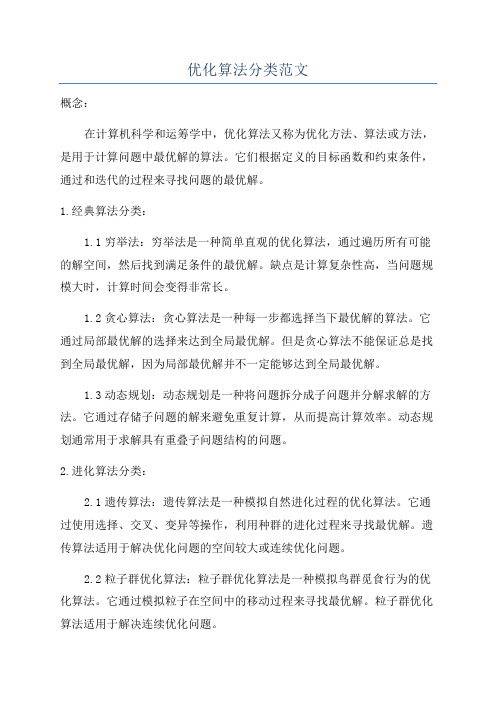
优化算法分类范文概念:在计算机科学和运筹学中,优化算法又称为优化方法、算法或方法,是用于计算问题中最优解的算法。
它们根据定义的目标函数和约束条件,通过和迭代的过程来寻找问题的最优解。
1.经典算法分类:1.1穷举法:穷举法是一种简单直观的优化算法,通过遍历所有可能的解空间,然后找到满足条件的最优解。
缺点是计算复杂性高,当问题规模大时,计算时间会变得非常长。
1.2贪心算法:贪心算法是一种每一步都选择当下最优解的算法。
它通过局部最优解的选择来达到全局最优解。
但是贪心算法不能保证总是找到全局最优解,因为局部最优解并不一定能够达到全局最优解。
1.3动态规划:动态规划是一种将问题拆分成子问题并分解求解的方法。
它通过存储子问题的解来避免重复计算,从而提高计算效率。
动态规划通常用于求解具有重叠子问题结构的问题。
2.进化算法分类:2.1遗传算法:遗传算法是一种模拟自然进化过程的优化算法。
它通过使用选择、交叉、变异等操作,利用种群的进化过程来寻找最优解。
遗传算法适用于解决优化问题的空间较大或连续优化问题。
2.2粒子群优化算法:粒子群优化算法是一种模拟鸟群觅食行为的优化算法。
它通过模拟粒子在空间中的移动过程来寻找最优解。
粒子群优化算法适用于解决连续优化问题。
2.3蚁群算法:蚁群算法是一种模拟蚂蚁觅食行为的优化算法。
它通过模拟蚂蚁在空间中的移动过程来寻找最优解。
蚁群算法适用于解决离散优化问题和组合优化问题。
3.局部算法分类:3.1爬山法:爬山法是一种局部算法,它通过在当前解的邻域中选择最优解来不断迭代地改进解。
但是爬山法容易陷入局部最优解,无法找到全局最优解。
3.2模拟退火算法:模拟退火算法是一种模拟金属退火过程的优化算法。
它通过在解空间中随机选择解,并根据一定的退火策略逐渐降低温度来寻找最优解。
3.3遗传局部算法:遗传局部算法是遗传算法和局部算法的结合。
它首先使用遗传算法生成一组解,并使用局部算法对这些解进行改进和优化。
机器学习常见优化算法
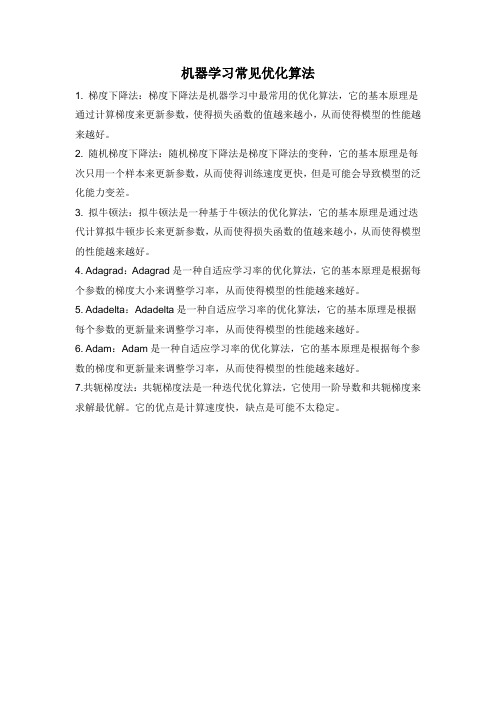
机器学习常见优化算法
1. 梯度下降法:梯度下降法是机器学习中最常用的优化算法,它的基本原理是通过计算梯度来更新参数,使得损失函数的值越来越小,从而使得模型的性能越来越好。
2. 随机梯度下降法:随机梯度下降法是梯度下降法的变种,它的基本原理是每次只用一个样本来更新参数,从而使得训练速度更快,但是可能会导致模型的泛化能力变差。
3. 拟牛顿法:拟牛顿法是一种基于牛顿法的优化算法,它的基本原理是通过迭代计算拟牛顿步长来更新参数,从而使得损失函数的值越来越小,从而使得模型的性能越来越好。
4. Adagrad:Adagrad是一种自适应学习率的优化算法,它的基本原理是根据每个参数的梯度大小来调整学习率,从而使得模型的性能越来越好。
5. Adadelta:Adadelta是一种自适应学习率的优化算法,它的基本原理是根据每个参数的更新量来调整学习率,从而使得模型的性能越来越好。
6. Adam:Adam是一种自适应学习率的优化算法,它的基本原理是根据每个参数的梯度和更新量来调整学习率,从而使得模型的性能越来越好。
7.共轭梯度法:共轭梯度法是一种迭代优化算法,它使用一阶导数和共轭梯度来求解最优解。
它的优点是计算速度快,缺点是可能不太稳定。
数学优化问题的求解方法
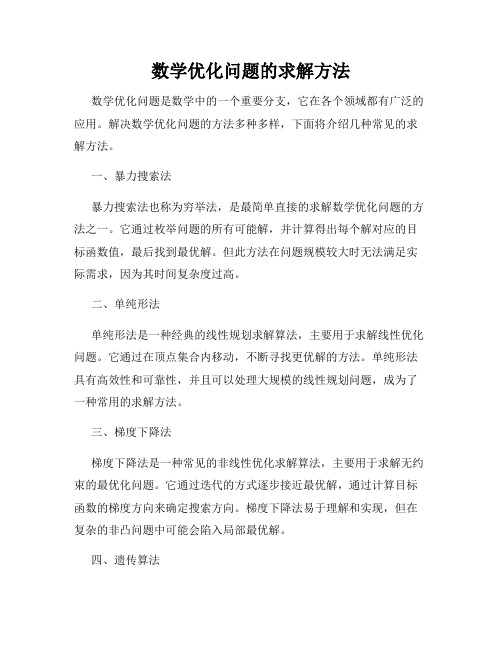
数学优化问题的求解方法数学优化问题是数学中的一个重要分支,它在各个领域都有广泛的应用。
解决数学优化问题的方法多种多样,下面将介绍几种常见的求解方法。
一、暴力搜索法暴力搜索法也称为穷举法,是最简单直接的求解数学优化问题的方法之一。
它通过枚举问题的所有可能解,并计算得出每个解对应的目标函数值,最后找到最优解。
但此方法在问题规模较大时无法满足实际需求,因为其时间复杂度过高。
二、单纯形法单纯形法是一种经典的线性规划求解算法,主要用于求解线性优化问题。
它通过在顶点集合内移动,不断寻找更优解的方法。
单纯形法具有高效性和可靠性,并且可以处理大规模的线性规划问题,成为了一种常用的求解方法。
三、梯度下降法梯度下降法是一种常见的非线性优化求解算法,主要用于求解无约束的最优化问题。
它通过迭代的方式逐步接近最优解,通过计算目标函数的梯度方向来确定搜索方向。
梯度下降法易于理解和实现,但在复杂的非凸问题中可能会陷入局部最优解。
四、遗传算法遗传算法是一种基于自然选择和遗传机制的优化算法,主要应用于复杂的非线性优化问题。
它通过模拟进化过程,利用选择、交叉和变异等操作,生成新的解,并根据适应度评估函数筛选出最优解。
遗传算法适用于多模态和多目标优化问题,但其计算量较大。
五、模拟退火算法模拟退火算法是一种随机搜索算法,主要应用于组合优化和全局优化问题。
它通过模拟固体物质退火过程中的晶格结构演化,寻找出合适的解。
模拟退火算法能够跳出局部最优解,找到全局最优解,但其收敛速度较慢。
六、动态规划法动态规划法适用于具有最优子结构的问题,通过将原问题划分为多个子问题,利用子问题的最优解推导出原问题的最优解。
动态规划法通常需要建立状态转移方程和选择最优策略,通过填表法来计算最优解。
动态规划法的时间复杂度通常较低,适用于一些具有递推性质的优化问题。
总结而言,数学优化问题的求解方法有很多种,每种方法都有其适用范围和特点。
选择合适的求解方法需要根据问题的具体情况来决定,包括约束条件、问题规模、目标函数形式等。
- 1、下载文档前请自行甄别文档内容的完整性,平台不提供额外的编辑、内容补充、找答案等附加服务。
- 2、"仅部分预览"的文档,不可在线预览部分如存在完整性等问题,可反馈申请退款(可完整预览的文档不适用该条件!)。
- 3、如文档侵犯您的权益,请联系客服反馈,我们会尽快为您处理(人工客服工作时间:9:00-18:30)。
Proximal AlgorithmsNeal ParikhDepartment of Computer ScienceStanford University npparikh@Stephen BoydDepartment of Electrical EngineeringStanford University boyd@Contents1Introduction 1231.1Definition . . . . . . . . . . . . . . . . . . . . . . . . . . 1241.2Interpretations . . . . . . . . . . . . . . . . . . . . . . . . 1241.3Proximal algorithms . . . . . . . . . . . . . . . . . . . . . 1261.4What this paper is about . . . . . . . . . . . . . . . . . . 127 1.5Related work . . . . . . . . . . . . . . . . . . . . . . . . . 1281.6Outline . . . . . . . . . . . . . . . . . . . . . . . . . . . . 1282Properties 1292.1Separable sum . . . . . . . . . . . . . . . . . . . . . . . . 1292.2Basic operations . . . . . . . . . . . . . . . . . . . . . . . 1302.3Fixed points . . . . . . . . . . . . . . . . . . . . . . . . . 1302.4Proximal average . . . . . . . . . . . . . . . . . . . . . . 1332.5Moreau decomposition . . . . . . . . . . . . . . . . . . . 1333Interpretations 1353.1Moreau-Yosida regularization . . . . . . . . . . . . . . . . 1353.2Resolvent of subdifferential operator . . . . . . . . . . . . 1373.3Modified gradient step . . . . . . . . . . . . . . . . . . . 1383.4Trust region problem . . . . . . . . . . . . . . . . . . . . 1393.5Notes and references . . . . . . . . . . . . . . . . . . . . 140iiiii 4Proximal Algorithms 1424.1Proximal minimization . . . . . . . . . . . . . . . . . . . . 1424.2Proximal gradient method . . . . . . . . . . . . . . . . . . 1484.3Accelerated proximal gradient method . . . . . . . . . . . 1524.4Alternating direction method of multipliers . . . . . . . . . 1534.5Notes and references . . . . . . . . . . . . . . . . . . . . 1595Parallel and Distributed Algorithms 1615.1Problem structure . . . . . . . . . . . . . . . . . . . . . . 1615.2Consensus . . . . . . . . . . . . . . . . . . . . . . . . . . 1635.3Exchange . . . . . . . . . . . . . . . . . . . . . . . . . . . 1675.4Allocation . . . . . . . . . . . . . . . . . . . . . . . . . . 1705.5Notes and references . . . . . . . . . . . . . . . . . . . . 1716Evaluating Proximal Operators 1726.1Generic methods . . . . . . . . . . . . . . . . . . . . . . . 1736.2Polyhedra . . . . . . . . . . . . . . . . . . . . . . . . . . 1796.3Cones . . . . . . . . . . . . . . . . . . . . . . . . . . . . 1836.4Pointwise maximum and supremum . . . . . . . . . . . . . 1856.5Norms and norm balls . . . . . . . . . . . . . . . . . . . . 1876.6Sublevel set and epigraph . . . . . . . . . . . . . . . . . . 1906.7Matrix functions . . . . . . . . . . . . . . . . . . . . . . . 1916.8Notes and references . . . . . . . . . . . . . . . . . . . . 1947Examples and Applications 1967.1Lasso . . . . . . . . . . . . . . . . . . . . . . . . . . . . . 1967.2Matrix decomposition . . . . . . . . . . . . . . . . . . . . 2007.3Multi-period portfolio optimization . . . . . . . . . . . . . 2047.4Stochastic optimization . . . . . . . . . . . . . . . . . . . 2097.5Robust and risk-averse optimization . . . . . . . . . . . . 2107.6Stochastic control . . . . . . . . . . . . . . . . . . . . . . 2118Conclusions 216AbstractThis monograph is about a class of optimization algorithms called proximal algorithms. Much like Newton’s method is a s tandard tool for solving unconstrained smooth optimization problems of modest size, proximal algorithms can be viewed as an analogous tool for nonsmooth, constrained, large-scale, or distributed versions of these problems. They are very generally applicable, but are especially well-suited to problems of substantial recent interest involving large or high-dimensional datasets. Proximal methods sit at a higher level of abstraction than classical algorithms like Newton’s method: the base operation is evaluatin g the proximal operator of a function, which itself involves solving a small convex optimization problem. These subproblems, which generalize the problem of projecting a point onto a convex set, often admit closedform solutions or can be solved very quickly with standard or simple specializedmethods. Here, we discuss the many different interpretations of proximal operators and algorithms, describe their connections to many other topics in optimization and applied mathematics, survey some popular algorithms, and provide a large number of examples of proximal operators that commonly arise in practice.1IntroductionThis monograph is about a class of algorithms, called proximal algorithms, for solving convex optimization problems. Much like Newton’s method is a standard tool for solving unconstrained smooth minimization problems of modest size, proximal algorithms can be viewed as an analogous tool for nonsmooth, constrained, large-scale, or distributed versions of these problems. They are very generally applicable, but they turn out to be especially well-suited to problems of recent and widespread interest involving large or high-dimensional datasets.Proximal methods sit at a higher level of abstraction than classical optimization algorithms like Newton’s method. In the latter, the base operations are low-level, consisting of linear algebra operations and the computation of gradients and Hessians. In proximal algorithms, the base operation is evaluating the proximal operator of a function, which involves solving a small convex optimization problem. These subproblems can be solved with standard methods, but they often admit closedform solutions or can be solved very quickly with simple specialized methods. We will alsosee that proximal operators and proximal algorithms have a number of interesting interpretations and are connected to many different topics in optimization and applied mathematics.123124 Introduction1.1 DefinitionLet f : R n → R ∪ ,+∞- be a closed proper convex function, which means that its epigraphepi f = {(x,t) ∈R n ×R | f(x) ≤ t}is a nonempty closed convex set. The effective domain of f isdom f = {x ∈R n | f(x) <+∞-,i.e., the set of points for which f takes on finite values.The proximal operator prox f : R n → R n of f is defined byprox f(v) = argmin!", (1.1)xwhere ∥ ·∥2 is the usual Euclidean norm. The function minimized on the righthand side is strongly convex and not everywhere infinite, so it has a unique minimizer for every v ∈R n (even when dom f ! R n).We will often encounter the proximal operator of the scaled function λf, where λ >0, which can be expressed asproxλf(v) = argmin!f(x) + (1/2λ)∥x −v∥22". (1.2)xThis is also called the proximal operator of f with parameter λ. (To keep notation light, we write (1/2λ) rather than (1/(2λ)).)Throughout this monograph, when we refer to the proximal operator of a function, the function will be assumed to be closed proper convex, and it may take on the extended value +∞.1.2 InterpretationsFigure 1.1 depicts what a proximal operator does. The thin black lines are level curves of a convex function f; the thicker black line indicates the boundary of its domain. Evaluating prox f at the blue points moves them to the corresponding red points. The three points in the domain of the function stay in the domain and move towards the minimum of the function, while the other two move to the boundary of the domain and towards the minimum of the function. The parameter λ controlsFigure 1.1: Evaluating a proximal operator at various points.the extent to which the proximal operator maps points towards the minimum of f, with larger values of λ associated with mapped points near the minimum, and smaller values giving a smaller movement towards the minimum. It may be useful to keep this figure in mind when reading about the subsequent interpretations.126 Introduction We now briefly describe some basic interpretations of (1.1) that we will revisit in more detail later. The definition indicates that prox f(v) is a point that compromises between minimizing f and being near to v. For this reason, prox f(v) is sometimes called a proximal point of v with respect to f. In proxλf, the parameter λ can be interpreted as a relative weight or trade-off parameter between these terms. When f is the indicator function0 xI C(x) = ⎨∞∈∈ CC⎧+ x ,⎩where C is a closed nonempty convex set, the proximal operator of f reduces to Euclidean projection onto C, which we denoteΠC(v) = argmin∥x −v∥2. (1.3)x∈CProximal operators can thus be viewed as generalized projections, and this perspective suggests various properties that we expect proximal operators to obey.The proximal operator of f can also be interpreted as a kind of gradient step for the function f. In particular, we have (under some assumptions described later) thatproxλf(v) ≈ v −λ∇f(v)when λ is small and f is differentiable. This suggests a close connection between proximal operators and gradient methods, and also hints that the proximal operator may be useful in optimization. It also suggests that λ will play a role similar to a step size in a gradient method.Finally, the fixed points of the proximal operator of f are precisely the minimizers of f (we will show this in §2.3). In other words, proxλf(x⋆) = x⋆if and only if x⋆minimizes f. This implies a close connection between proximal operators and fixed point theory, and suggests that proximal algorithms can be interpreted as solving optimization problems by finding fixed points of appropriate operators.1.3 Proximal algorithmsA proximal algorithm is an algorithm for solving a convex optimization problem that uses the proximal operators of the objective terms. For example, the proximal minimization algorithm, discussed in more detail in §4.1, minimizes a convex function f by repeatedly applying prox f to some initial point x0. The interpretations of prox f above suggest several potential perspectives on this algorithm, such as an approximate gradient method or a fixed point iteration. In Chapters 4 and 5 we will encounter less trivial and far more useful proximal algorithms.Proximal algorithms are most useful when all the relevant proximal operators can be evaluated sufficiently quickly. In Chapter 6, we discuss how to evaluate proximal operators and provide many examples.1.4. What this paper is about 127There are many reasons to study proximal algorithms. First, they work under extremely general conditions, including cases where the functions are nonsmooth and extended real-valued (so they contain implicit constraints). Second, they can be fast, since there can be simple proximal operators for functions that are otherwise challenging to handle in an optimization problem. Third, they are amenable to distributed optimization, so they can be used to solve very large scale problems. Finally, they are often conceptually and mathematically simple, so they are easy to understand, derive, and implement for a particular problem. Indeed, many proximal algorithms can be interpreted as generalizations of other well-known and widely used algorithms, like the projected gradient method, so they are a natural addition to the basic optimization toolbox for anyone who uses convex optimization.1.4 What this paper is aboutWe aim to provide a readable reference on proximal operators and proximal algorithms for a wide audience. There are several novel aspects.First, we discuss a large number of different perspectives on proximal operators, some of which have not previously appeared in the literature, and many of which have not been collected in one place. These include interpretations based on projection operators, smoothing and regularization, resolvent operators, and differential equations. Second, we128 Introduction place strong emphasis on practical use, so we provide many examples ofproximal operators that are efficient to evaluate. Third, we have a moredetailed discussion of distributed optimization algorithms than mostprevious references on proximal operators.To keep the treatment accessible, we have omitted a few moreadvanced topics, such as the connection to monotone operator theory.We also include source code for all examples, as well as a library ofimplementations of proximal operators, at/~boyd/papers/prox_algs.htmlWe provide links to other libraries of proximal operators, such as those byBecker et al. and Vaiter, in the documentation for our own library.1.5 Related workWe emphasize that proximal operators are not new and that there havebeen other surveys written on various aspects of this topic over the years.Lemaire [121] surveys the literature on the proximal point algorithm up to1989. Iusem [108] reviews the proximal point method and its connectionto augmented Lagrangians. An excellent recent reference by Combettesand Pesquet [61] discusses proximal operators and proximal algorithms inthe context of signal processing problems. The lecture notes forVandenberghe’s EE 236C course *194+ covers proximal algorithms in detail.Finally, the recent monograph by Boyd et al. [32] is about a particularalgorithm (ADMM), but also discusses connections to proximal operators.We will discuss more of the history of proximal operators in the sequel.1.6 OutlineIn Chapter 2, we give some basic properties of proximal operators. In Chapter 3, we discuss a variety of interpretations of proximal operators. Chapter 4 covers some core proximal algorithms for solving convex optimization problems. In Chapter 5, we discuss how to use these algorithms to solve problems in a parallel or distributed fashion. Chapter 6 presents a large number of examples of different projection and proximal operators that can be evaluated efficiently. In Chapter 7, we illustrate these ideas with some examples and applications.2PropertiesWe begin by discussing the main properties of proximal operators. These are used to, for example, establish convergence of a proximal algorithm or to derive a method for evaluating the proximal operator of a given function. All of these properties are well-known in the literature; see, e.g., [61, 193, 10].2.1 Separable sumIf f is separable across two variables, so f(x,y) = ϕ(x) + ψ(y), then prox f(v,w) = (proxϕ(v),proxψ(w)). (2.1)Thus, evaluating the proximal operator of a separable function reduces to evaluating the proximal operators for each of the separable parts, which can be done independently.If f is fully separable, meaning that f(x) = &n i=1 f i(x i), then(prox f(v))i = prox f i(v i).130 Introduction In other words, this case reduces to evaluating proximal operators of scalarfunctions. We will see in Chapter 5 that the separable sum property is thekey to deriving parallel versions of proximal algorithms.1292.2 Basic operationsThis section can be referred to as needed; these properties will not play a central role in the rest of the paper.Postcomposition. If f(x) = αϕ(x) + b, with α >0, thenproxλf(v) = proxαλϕ(v).Precomposition. If f(x) = ϕ(αx + b), with α = 0̸, then1proxλf(v) = !proxα2λϕ(αv + b) −b". (2.2) αIf f(x) = ϕ(Qx), where Q is orthogonal (QQ T = Q T Q = I), thenproxλf(v) = Q T proxλϕ(Qv).There are other specialized results about evaluating prox f via proxϕ, where f(x) = ϕ(Ax) for some matrix A. Several of these are useful in image and signal processing; see, e.g., [60, 165, 166, 21].Affine addition. If f(x) = ϕ(x) + a T x + b, thenproxλf(v) = proxλϕ(v −λa).Regularization. If f(x) = ϕ(x) + (ρ/2)∥x −a∥22, thenproxλf(v) = proxλϕ˜ !(λ˜/λ)v + (ρλ˜)a", where λ˜ =λ/(1 + λρ).2.3 Fixed pointsThe point x⋆minimizes f if and only ifx⋆= prox f(x⋆),i.e., if x⋆is a fixed point of prox f. (We can consider λ = 1 without loss of generality, since x⋆minimizes f if and only if it minimizes λf.) This132 Properties fundamental property gives a link between proximal operators and fixedpoint theory; e.g., many proximal algorithms for optimization can beinterpreted as methods for finding fixed points of appropriate operators.This viewpoint is often useful in the analysis of these methods.2.3. Fixed points 131 Proof. We can show directly that if x⋆minimizes f, then prox f(x⋆) = x⋆. We assume for convenience that f is subdifferentiable on its domain, thoughthe result is true in general.If x⋆minimizes f, i.e., f(x) ≥ f(x⋆) for any x, then ffor any x, so x⋆minimizes the function f(x)+(1/2)∥x−x⋆∥22. It follows that x⋆= prox f(x⋆).To show the converse, we use the subdifferential characterization ofthe minimum of a convex function *169+. The point ˜x minimizesf(so ˜x = prox f(v)) if and only if0 ∈∂f(x˜) + (x˜ −v),where the sum is of a set and a point. Here, ∂f(x) ⊂R n is the subdifferential of f at x, defined by∂f(x) = {y | f(z) ≥ f(x) + y T (z −x) for all z ∈dom f}. (2.3) Taking ˜x = v = x⋆, it follows that 0 ∈∂f(x⋆), so x⋆minimizes f. !Fixed point algorithms. Since minimizers of f are fixed points of prox f, wecan minimize f by finding a fixed point of its proximal operator. If prox fwere a contraction, i.e., Lipschitz continuous with constant less than 1,repeatedly applying prox f would find a (here, unique) fixed point. It turnsout that while prox f need not be a contraction (unless f is strongly convex),it does have a different property, firm nonexpansiveness, sufficient for fixed point iteration:∥prox f(x) −prox f(prox f(x) −prox f(y))for all x, y ∈R n.Firmly nonexpansive operators are special cases of nonexpansive operators (those that are Lipschitz continuous with constant 1). Iteration of a general nonexpansive operator need not converge to a fixed point: consider operators like −I or rotations. However, it turns out that if N is nonexpansive, then the operator T = (1−α)I +αN, where α ∈ (0,1), has the same fixed points as N and simple iteration of T will converge to a fixed point of T (and thus of N), i.e., the sequencex k+1 := (1 −α)x k + αN(x k)will converge to a fixed point of N. Put differently, damped iteration of a nonexpansive operator will converge to one of its fixed points.Operators in the form (1 −α)I + αN, where N is nonexpansive and α ∈(0,1), are called α-averaged operators. Firmly nonexpansive operators are averaged: indeed, they are precisely the (1/2)-averaged operators. In summary, both contractions and firm nonexpansions are subsets of the class of averaged operators, which in turn are a subset of all nonexpansive operators.Averaged operators are useful because they satisfy some properties that are desirable in devising fixed point methods, and because they are a common parent of contractions and firm nonexpansions. For example, the class of averaged operators is closed under composition, unlike that of firm nonexpansions, i.e., the composition of firmly nonexpansive operators need not be firmly nonexpansive but is always averaged. In addition, as mentioned above, simple iteration of an averaged operator will converge to a fixed point if one exists, a result known as the Krasnoselskii-Mann theorem. Explicitly, suppose T is averaged and has a fixed point. Define the iterationx k+1 := T(x k)134 Propertieswith arbitrary x0. Then ∥T(x k)−x k∥→ 0 as k →∞ and x k converges to a fixed point of T[10, §5.2]; also see, e.g., [133, 40, 15, 97, 59]. This immediately suggests the simplest proximal method,x k+1 := proxλf(x k),which is called proximal minimization or the proximal point algorithm. We discuss it in detail in §4.1; for example, it converges under the mildest possible assumption, which is simply that a minimizer exists.2.4. Proximal average 1332.4 Proximal averageLet f1, ..., f m be closed proper convex functions. Then we have that1 mm'i=1 prox f i = prox g,where g is a function called the proximal average of f1, ..., f m. In other words, the average of the proximal operators of a set of functions is itself the proximal operator of some function, and this function is called the proximal average. This operator is fundamental and often appears in parallel proximal algorithms, which we discuss in Chapter 5. For example, such algorithms typically involve a step that evaluates the proximal operator of a number of functions independently in parallel and then averages the results.The proximal average has a number of interesting properties. For example, the minimizers of g are the minimizers of the sum of the Moreau envelopes (see §3.1) of the f i. See [12] for more discussion.2.5 Moreau decompositionThe following relation always holds:v = prox f(v) + prox f∗(v), (2.4)wheref∗(y) = sup y T x −f(x)x ! "is the convex conjugate of f. This property, known as Moreau decomposition, is the main relationship between proximal operators and duality.The Moreau decomposition can be viewed as a generalization of orthogonal decomposition induced by a subspace. If L is a subspace, then its orthogonal complement isL⊥= {y | y T x = 0 for all x ∈L},and we have that, for any v,v = ΠL(v) + ΠL⊥(v).This follows from Moreau decomposition since (I L)∗= I L⊥.Similarly, when f is the indicator function of the closed convex cone K, we have thatv = ΠK(v) + ΠK◦(v),whereK◦= {y | y T x ≤ 0 for all x ∈K}is the polar cone of K, which is the negative of the dual coneK∗= {y | y T x ≥ 0 for all x ∈K}.Moreau decomposition gives a simple way to obtain the proximal operator of a function f in terms of the proximal operator of f∗. For example, if f = ∥ ·∥ is a general norm, then f∗= I B, whereB = {x | ∥x∥∗≤ 1-is the unit ball for the dual norm ∥ ·∥∗, defined by∥z∥∗= sup{z T x | ∥x∥≤ 1-.By Moreau decomposition, this implies thatv = prox f(v) + ΠB(v).136 Properties In other words, we can easily evaluate prox f if we know how to projectonto B (and vice versa). This example is discussed in detail in §6.5.3InterpretationsHere we collect a variety of interpretations of proximal operators and discuss them in detail. They are useful for developing intuition about proximal operators and for giving interpretations of proximal algorithms. For example, we have seen that proximal operators can be viewed as a generalization of projections, and we will see that some proximal algorithms are generalizations of projection algorithms.3.1 Moreau-Yosida regularizationThe infimal convolution of closed proper convex functions f and g onR n, denoted f !g, is defined as(f !g)(v) = inf (f(x) + g(v −x)), xwith dom(f !g) = dom f + dom g.The main example relevant here is the following. Given λ >0, theMoreau envelope or Moreau-Yosida regularization Mλf of the function λf is defined as Mλf = λf !(1/2)∥ ·∥22, i.e.,M. (3.1)This is also referred to as the Moreau envelope of f with parameter λ.135138 Interpretations The Moreau envelope M f is essentially a smoothed or regularized form of f: It has domain R n, even when f does not, and it is continuously differentiable, even when f is not. In addition, the sets of minimizers of f and M f are the same. The problems of minimizing f and M f are thus equivalent, and the latter is always a smooth optimization problem (with the caveat that M f may be difficult to evaluate). Indeed, some algorithms for minimizing f are better interpreted as algorithms for minimizing M f, as we will see.To see why M f is a smoothed form of f, consider that(f !g)∗= f∗+ g∗,i.e., that infimal convolution is dual to addition [169, §16]. Because M f∗∗= M f and (1/2)∥ ·∥22 is self-dual, it follows thatM f .In general, the conjugate ϕ∗of a closed proper convex function ϕis smooth when ϕis strongly convex. This suggests that the Moreau envelope M f can be interpreted as obtaining a smooth approximation to a function by taking its conjugate, adding regularization, and then taking the conjugate again. With no regularization, this would simply give the original function; with the quadratic regularization, it gives a smooth approximation. For example, applying this technique to |x| gives the Huber function⎧ϕhuber(x) =| | ≤ x2 x⎨12|x| − 1|x| >1.This perspective is very related to recent work by Nesterov [⎩150]; for more on this connection, see [19].The proximal operator and Moreau envelope of f share many relationships. For example, prox f returns the (unique) point that actually achieves the infimum that defines M f, i.e.,M f(x) = f(prox f(x)) + (1/2)∥x −prox f.139 In addition, the gradient of the Moreau envelope is given by∇Mλf(x) = (1/λ)(x −proxλf(x)). (3.2) 3.2. Resolvent of subdifferential operatorWe can rewrite this asproxλf(x) = x −λ∇Mλf(x), (3.3) which shows that proxλf can be viewed as a gradient step, with step size λ, for minimizing Mλf (which has the same minimizers as f). Combining this with the Moreau decomposition (2.4) gives a formula relating the proximal operator, Moreau envelope, and the conjugate:prox f(x) = ∇M f∗(x).It is possible to consider infimal convolution and the Moreau envelope for nonconvex functions, in which case some, but not all, of the properties given above hold; see, e.g., [161]. We limit the discussion here to the case when the functions are convex.3.2 Resolvent of subdifferential operatorWe can view the subdifferential operator ∂f, defined in (2.3), of a closed proper convex function f as a point-to-set mapping or a relation on R n, i.e., ∂f takes each point x ∈dom f to the set ∂f(x). Any point y ∈∂f(x) is called a subgradient of f at x. When f is differentiable, we have ∂f(x) = {∇f(x)} for all x; we refer to the (point-to-point) mapping ∇f from x ∈dom f to ∇f(x) as the gradient mapping.The proximal operator proxλf and the subdifferential operator ∂f are related as follows:proxλf = (I + λ∂f)−1. (3.4)140 Interpretations The (point-to-point) mapping (I + λ∂f)−1 is called the resolvent of the operator ∂f with parameter λ >0, so the proximal operator is the resolvent of the subdifferential operator.The resolvent formula (3.4) must be interpreted carefully. All the operators on the righthand side (scalar multiplication, sum, and inverse) are operations on relations, so (I +λ∂f)−1 is a relation. It turns out, however, that this relation has domain R n, is single-valued, and so is a function, even though ∂f is not.Proof of (3.4). As before, we assume for convenience that f is subdifferentiable on its domain. By definition, if z ∈ (I + λ∂f)−1(x), thenx ∈ (I + λ∂f)(z) = z + λ∂f(z).This can be expressed as0 ∈∂f(z) + (1/λ)(z −x),which can in turn be rewritten as",where the subdifferential is with respect to z.As in §2.3, this is the necessary and sufficient condition for z to minimize the strongly convex function within the parentheses above:z = argmin!f(u) + (1/2λ)∥u −x∥22".uThis shows that z ∈ (I + λ∂f)−1(x) if and only if z = proxλf(x) and, in particular, that (I + λ∂f)−1 is single-valued. !141 3.3 Modified gradient stepThere are several ways of interpreting the proximal operator as a gradient step for minimizing f or a function related to f. For instance, we have already seen in (3.3) thatproxλf(x) = x −λ∇Mλf(x),i.e., proxλf is a gradient step for minimizing the Moreau envelope of f with step size λ. Here we discuss other similar interpretations.If f is twice differentiable at x, with ∇2f(x) ≻0 (i.e., with ∇2f(x) positive definite), then, as λ→ 0, proxλf(x) = (I + λ∇f)−1(x) = x −λ∇f(x) + o(λ).In other words, for small λ, proxλf(x) converges to a gradient step in f with step length λ. So the proximal operator can be interpreted (for small λ) as an approximation of a gradient step for minimizing f.3.4. Trust region problemWe now consider proximal operators of approximations to f and examine their relation to gradient (or other) steps for minimizing f. If f is differentiable, its first-order approximation near v isfˆv(1)(x) = f(v) + ∇f(v)T (x −v),and if it is twice differentiable, its second-order approximation is fˆv(2)(x) = f(v) + ∇f(v)T (x −v) + (1/2)(x −v)T ∇2f(v)(x −v).The proximal operator of the first-order approximation isprox fˆ,which is a standard gradient step with step length λ. The proximal operator of the second-order approximation isprox fˆ.。
